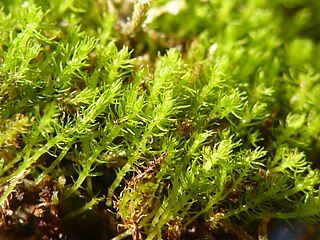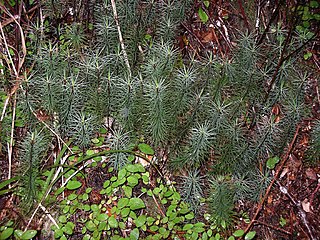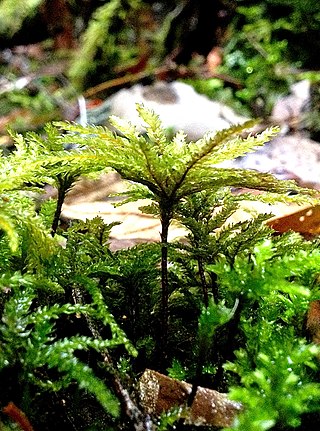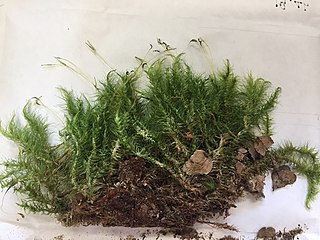
Mosses are small, non-vascular flowerless plants in the taxonomic division Bryophytasensu stricto. Bryophyta may also refer to the parent group bryophytes, which comprise liverworts, mosses, and hornworts. Mosses typically form dense green clumps or mats, often in damp or shady locations. The individual plants are usually composed of simple leaves that are generally only one cell thick, attached to a stem that may be branched or unbranched and has only a limited role in conducting water and nutrients. Although some species have conducting tissues, these are generally poorly developed and structurally different from similar tissue found in vascular plants. Mosses do not have seeds and after fertilisation develop sporophytes with unbranched stalks topped with single capsules containing spores. They are typically 0.2–10 cm (0.1–3.9 in) tall, though some species are much larger. Dawsonia, the tallest moss in the world, can grow to 50 cm (20 in) in height. There are approximately 12,000 species.

The Marchantiophyta are a division of non-vascular land plants commonly referred to as hepatics or liverworts. Like mosses and hornworts, they have a gametophyte-dominant life cycle, in which cells of the plant carry only a single set of genetic information.

Takakia is a genus of two species of mosses known from western North America and central and eastern Asia. The genus is placed as a separate family, order and class among the mosses. It has had a history of uncertain placement, but the discovery of sporophytes clearly of the moss-type firmly supports placement with the mosses.

Aesculus californica, commonly known as the California buckeye or California horse-chestnut, is a species of buckeye native to California and southwestern Oregon.

Eucalyptus cladocalyx, commonly known as sugar gum, is a species of eucalypt tree found in the Australian state of South Australia. It is found naturally in three distinct populations - in the Flinders Ranges, Eyre Peninsula and on Kangaroo Island.

Polytrichum commune is a species of moss found in many regions with high humidity and rainfall. The species can be exceptionally tall for a moss with stems often exceeding 30 cm (12 in) though rarely reaching 70 cm (27.5 in), but it is most commonly found at shorter lengths of 5 to 10 cm. It is widely distributed throughout temperate and boreal latitudes in the Northern Hemisphere and also found in Mexico, several Pacific Islands including New Zealand, and also in Australia. It typically grows in bogs, wet heathland and along forest streams.

Syncarpia glomulifera, commonly known as the turpentine tree, or yanderra, is a tree of the family Myrtaceae native to New South Wales and Queensland in Australia, which can reach 60 metres in height. It generally grows on heavier soils. The cream flowers appear in spring and are fused into compound flowerheads.

Tetraphidaceae is a family of mosses. It includes only the two genera Tetraphis and Tetrodontium, each with two species. The defining feature of the family is the 4-toothed peristome.

Polytrichum is a genus of mosses — commonly called haircap moss or hair moss — which contains approximately 70 species that cover a cosmopolitan distribution. The genus Polytrichum has a number of closely related sporophytic characters. The scientific name is derived from the Ancient Greek words polys, meaning "many", and thrix, meaning "hair". This name was used in ancient times to refer to plants with fine, hairlike parts, including mosses, but this application specifically refers to the hairy calyptras found on young sporophytes. A similar naming related to hair appears in Old Norse, haddr silfjar, "hair of Sif", goddess from Norse Mythology, wife of the god Thor. There are two major sections of Polytrichum species. The first — section Polytrichum — has narrow, toothed, and relatively erect leaf margins. The other — section Juniperifolia — has broad, entire, and sharply inflexed leaf margins that enclose the lamellae on the upper leaf surface. Polytrichum reproduce by vegetative and sexual methods.

Ceratodon purpureus is a dioicous moss with a color ranging from yellow-green to red. The height amounts to 3 centimeters. It is found worldwide, mainly in urban areas and next to roads on dry sand soils. It can grow in a very wide variety of habitats, from polluted highway shoulders and mine tailings to areas recently denuded by wildfire to the bright slopes of Antarctica. Its common names include redshank, purple forkmoss, ceratodon moss, fire moss, and purple horn toothed moss.

Dicranum scoparium, the broom forkmoss, is a species of dicranid moss, native to most of the northern hemisphere as well as Oceania. It usually forms tufts or mats on soil in dry to moist forested areas. As with many types of moss Broom moss grows in clumps with Broom mosses as well as other mosses. It can be distinguished by its leaves, which strongly curve to one side.

Itatiella ulei is a species of moss in the family Polytrichaceae. It is the only species in the genus Itatiella. The Polytrichaceae is a common family of mosses that does not have close living relatives. Its small size and the inflexed leaf apex characterize Itatiella ulei. When this species grows directly exposed to sun at high elevations, it presents a similar aspect but can be distinguished based on the distal lamella cells which are single and rhombic.

Dawsonia is a genus of acrocarpous mosses. Dawsonia, along with other members of the order Polytrichales, are taller than most mosses and have thicker leaves. Their sporophytes have conducting systems analogous to those of vascular plants. Dawsonia superba is found in New Zealand, Australia and New Guinea. D. longifolia is found in the Philippines, Indonesia, Malaysia, and Australia. There is uncertainty as to whether D. superba and D. longifolia are actually distinct species.

Dawsonia superba is a moss in the class Polytrichaceae that is found in Australia, New Guinea, Malaysia and New Zealand. D. superba is the tallest self-supporting moss in the world, reaching heights of 60 cm (24 in). It has analogous structures to those in vascular plants that support large size, including hydroid and leptoid cells to conduct water and photosynthate, and lamellae that provide gas chambers for more efficient photosynthesis. D. superba is a member of the class Polytrichopsida, although it has a sporophyte that is unique from other hair-cap mosses.

Hypnodendron comosum, commonly known as palm moss or palm tree moss, is a ground moss which can be divided into two varieties: Hypnodendron comosum var. comosum and Hypnodendron comosum var. sieberi. Both Hypnodendron varieties most commonly grow in damp locations in the temperate and tropical rainforests of New South Wales, Victoria, and Tasmania in southern Australia and in New Zealand.
Bartramia nothostricta is a species of mosses in the family Bertramiaceae and is endemic to the south-east of Australia. It grows in small colonies in moist places, and is recognised by its leaves which look like a shaving brush and by its bright green, spherical, lollipop-like capsules.

Climacium dendroides, also known as tree climacium moss, belongs in the order Hypnales and family Climaciaceae, in class Bryopsida and subclass Bryidae. It is identified as a "tree moss" due to its distinctive morphological features, and has four species identified across the Northern Hemisphere. The species name "dendroides" describes the tree-like morphology of the plant, and its genus name came from the structure of the perforations of peristome teeth. This plant was identified by Weber and Mohr in 1804. They often have stems that are around 2-10 cm tall and growing in the form of patches, looking like small palm-trees. They have yellow-green branches at the tip of stems. The leaves are around 2.5-3 mm long, with rounder stem leaves and pointier branch leaves. Their sporophytes are only abundant in late winter and early spring, and appears as a red-brown shoot with long stalk and cylindrical capsules.

Dicranoloma dicarpum is relatively common moss which is widespread in the Southern Hemisphere. The genus Dicranoloma has 40 species, which share the features of long stems, wispy and twisted leaves, and large, erect capsules. The genus is dominant in wet forest habitats in Australia and New Zealand.

Polytrichastrum formosum, commonly known as the bank haircap moss, is a species of moss belonging to the family Polytrichaceae.

Polytrichum piliferum, the bristly haircap, is an evergreen perennial species of moss in the family Polytrichaceae. The bristly haircap moss is small-sized to medium-sized and forms loose tufts with wine-reddish stems. It is an acrocarpous moss that appears bluish-green to grey. This moss grows in clumps on erect shoots and becomes a red-brown colour as it grows older. The most distinguishing feature of P. piliferum is the long, white awn at the tips of the leaves, which also give this moss its grey colour. It is the only species in its genus where the awn is completely hyaline.



















